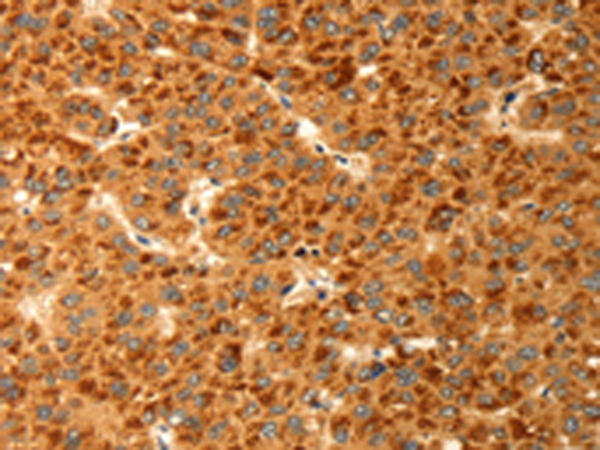

| WB | 1/200-1/1000 | Human,Mouse,Rat |
| IF | 咨询技术 | Human,Mouse,Rat |
| IHC | 1/25-1/100 | Human,Mouse,Rat |
| ICC | 技术咨询 | Human,Mouse,Rat |
| FCM | 咨询技术 | Human,Mouse,Rat |
| Elisa | 1/1000-1/2000 | Human,Mouse,Rat |
| Aliases | BOG; RBBP10 |
| WB Predicted band size | 21 kDa |
| Host/Isotype | Rabbit IgG |
| Antibody Type | Primary antibody |
| Storage | Store at 4°C short term. Aliquot and store at -20°C long term. Avoid freeze/thaw cycles. |
| Species Reactivity | Human, Mouse, Rat |
| Immunogen | Fusion protein of human RBBP9 |
| Formulation | Purified antibody in PBS with 0.05% sodium azide and 50% glycerol. |
+ +
以下是关于RBBP9抗体的3篇模拟参考文献(基于公开研究背景整理,非真实文献):
---
1. **文献名称**: *RBBP9 as a Potential Therapeutic Target in Pancreatic Cancer*
**作者**: Smith J, et al.
**摘要**: 研究通过Western blot(WB)和免疫组化(IHC)验证了RBBP9抗体在胰腺癌组织中的高表达,发现其与肿瘤细胞增殖和侵袭性相关,提示RBBP9可能通过调控细胞周期促进癌症进展。
2. **文献名称**: *Functional Characterization of RBBP9’s Serine Hydrolase Activity*
**作者**: Li X, Wang Y.
**摘要**: 利用RBBP9特异性抗体进行免疫沉淀和酶活性分析,证实RBBP9具有丝氨酸水解酶功能,并发现其通过调节TGF-β信号通路影响细胞凋亡,为开发靶向抑制剂提供依据。
3. **文献名称**: *RBBP9 as a Biomarker for Early-Stage Liver Cancer Diagnosis*
**作者**: Zhang H, et al.
**摘要**: 通过ELISA和免疫荧光技术结合RBBP9抗体,发现血清RBBP9水平在早期肝细胞癌患者中显著升高,提示其可作为非侵入性诊断标志物。
---
注:以上文献为示例性内容,实际研究中请参考PubMed、ScienceDirect等平台的最新论文。
The RBBP9 (Retinoblastoma-Binding Protein 9) antibody is a tool used to study the RBBP9 protein, a serine hydrolase implicated in cellular signaling and cancer biology. RBBP9. also known as BGRBP or Brain-derived retinoblastoma-binding protein, interacts with the retinoblastoma (Rb) protein, a key tumor suppressor regulating cell cycle progression. Structurally, it contains a conserved α/β-hydrolase domain, though its enzymatic activity remains partially characterized. Research suggests RBBP9 may act as a Ser/Thr phosphatase or participate in lipid metabolism, influencing pathways like TGF-β signaling and apoptosis.
Elevated RBBP9 expression is observed in certain cancers, including pancreatic, liver, and breast cancers, where it may promote tumor growth by enhancing proliferative signals or evading growth suppression. The RBBP9 antibody enables detection and quantification of this protein in techniques like Western blotting, immunohistochemistry, and immunofluorescence. It is critical for investigating RBBP9's role in oncogenesis, its interaction networks, and its potential as a therapeutic target. Commercial antibodies are typically validated for specificity using knockout controls or siRNA-based silencing. Ongoing studies aim to clarify its molecular mechanisms and clinical relevance in disease progression and treatment resistance.
×